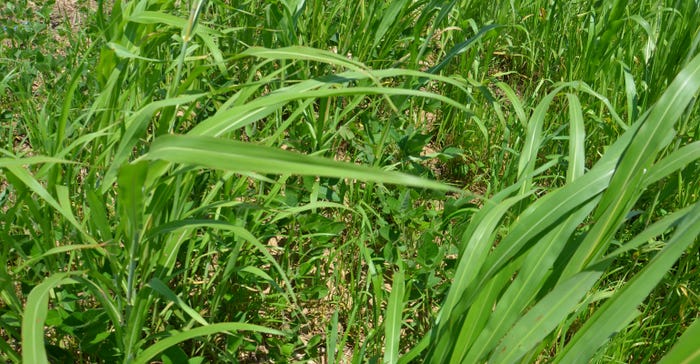
Marestail and waterhemp aren’t the only troublesome weeds around. There are also weeds such as Canada thistle, shattercane and johnsongrass that have been thorns in many growers’ sides for decades.
Bill Johnson, Purdue University Extension weed control specialist, examined photos of two different field situations where one or more of these pesky weeds were present. He offers advice for these situations.
1. Canada thistle. This weed in the photo above is easy to identify, even among other thistles, Johnson says. Note the leaf shape. It produces a purple bloom in late spring, which then produces seed. Spring is a good time to spray and get effective results if you can’t spray in the fall, Johnson notes. Canada thistle is a perennial that produces rhizomes. Allowed to become established, it can produce an extensive network of underground roots.
If the soybeans in the field are Xtend, hit the thistle with dicamba, following label directions, Johnson says. In Enlist soybeans, the 2,4-D choline in Enlist One or Enlist Duo will work on it. If you’re spraying before planting, check for any plant-back restrictions.
You may also burn back the weeds with some other postemergence sprays, but you’re not going to wipe them out, Johnson says. Expect some plants to survive. If allowed to compete too long with crops, expect an impact on yield, even if you do knock back weeds.
The best control window for thistles is in the fall, when you can hit young, active regrowth before a frost with herbicides that translocate into the rhizomes. You still shouldn’t expect to clean out a thick patch with one application, he notes.
In corn during the season, attack Canada thistle with Banvel and Stinger, Johnson advises.
2. Shattercane or johnsongrass? The grass-type weed here appears to be shattercane, but if you find this scene in your field, investigate, Johnson says. Dig plants up. If there are rhizomes mixed in with fibrous roots, it’s johnsongrass. Once these plants produce seed, it would be easy to identify them. But it would be too late to prevent crop loss or control them. They’re already taller than preferred for spraying.

OTHER PESKY WEEDS: If you see these weeds in your field, the first step is to determine if it’s shattercane or johnsongrass, Bill Johnson says. That will shape recommendations for control.

Shattercane is an annual. Glyphosate is effective at controlling it, Johnson says. Glyphosate will also control johnsongrass, but not if it’s glyphosate-resistant. If it’s johnsongrass and glyphosate doesn’t control it, assume it’s resistant. Add a grass herbicide such as Select or Assure to the tank.
About the Author(s)
You May Also Like




